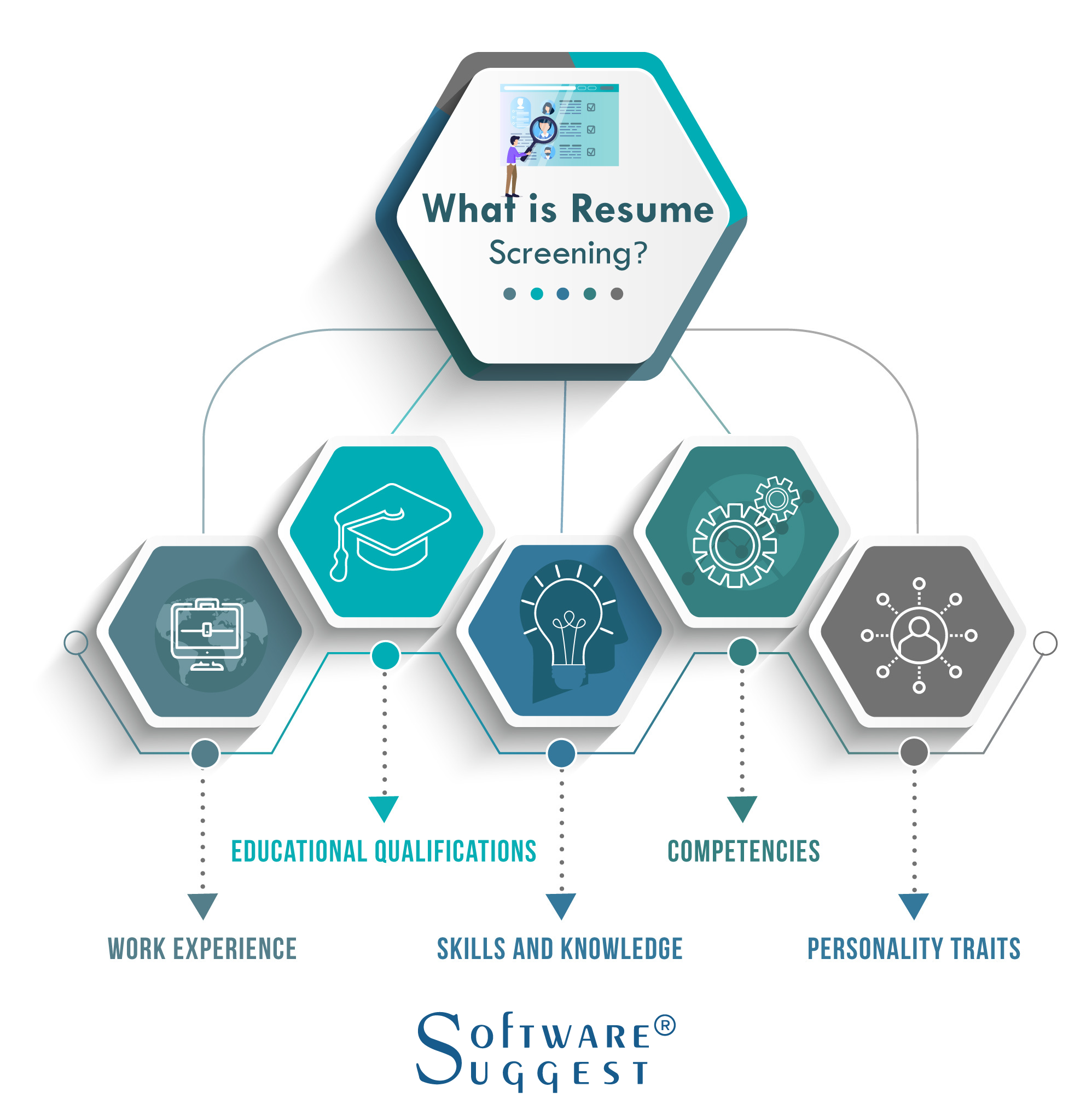To hire the right person at the right time, recruiters must be able to screen resumes correctly. The essence of any good recruitment strategy lies in efficient and effective resume screening. And yet, research by TheLadders has shown that on an average, a recruiter spends just about 6 seconds reviewing a CV.
Some interesting facts to put things into perspective:
Glassdoor Economic Research found the average time taken for a single hire is 23 days.
According to Ideal, screening resumes take up to 23 hours for just one hire.
According to Glassdoor, of 250 job applicants, only 4-6 candidates are interviewed and 1 will be given a job offer.
According to industry stats, 75% to 88% of the 250 applicants are usually unqualified.
Another survey by Jobvite shows that for every high-volume job posting that is likely to attract over 250 applicants, 65% of them are completely ignored.
It comes as no surprise then, that according to Ideal, “52% of Talent Acquisition leaders say that the hardest part of recruitment is screening candidates from a large applicant pool.”
What is Resume Screening?
The objective of resume screening is to locate the most qualified candidates for an open job. It involves sorting through resumes, manually or through resume screening software, for identifying candidates who may be qualified to fill a role. This is done by matching the job requirements with the qualifications of the candidate, which may usually include, but are not limited to factors such as
- Work Experience
- Educational Qualifications
- Skills and Knowledge
- Competencies
- Personality Traits

Based on this, it may be decided whether to move forward with a candidate’s application, typically on to an interview, or to reject them.
How to Screen Resumes?
Qualifications are broadly divided into two categories:
1. Minimum Qualifications
These are qualifications a candidate must absolutely possess to qualify for a job opening. For example, the candidate must be at least 18 years of age.
2. Preferred Qualifications
These are qualifications that, while not absolutely required, are nice to have and increase a candidate’s chances of being a better fit for the role. For example, prior work experience in the same industry.
There are 3 steps that are usually involved in the resume screening process:
#Step1 : Screening resumes based on minimum qualifications
#Step2 : Screening resumes based on preferred qualifications
#Step3 : Shortlisting candidates based on the minimum and preferred qualifications
The third step involves deciding how much importance must be placed on the preferred qualifications to shortlist candidates. Not all candidates may meet the minimum as well as preferred requirements. For high-volume hiring, minimum qualifications may be enough. For low-volume hiring, a combination or both minimum and preferred qualifications are given priority.
Guidelines for Effective Screening

Here’s what can help recruiters do a better job of screening resumes:
1. Build a clear, specific, and concise job description.
The job description must clearly convey details about the role and the type of candidate required. It must leave nothing to the recruiter’s or the candidate’s interpretation.
2. Talk to the hiring manager.
An in-depth discussion with the hiring manager will ensure that they both understand the role similarly and that they are on the same page. A hiring manager may be able to share some more insights into the ideal candidate that may have not been captured on the job description.
3. Look for red flags.
Recruiters should attempt to stop red flags such as frequent job changes, gaps in employment, employment dates not adding up, etc.
4. Identify keyword stuffing.
Candidates stuff their resumes with certain keywords that they know recruiters will most likely be looking for, even if they may not apply to them. Recruiters must be vigilant about that.
5. Introduce layers of testing into the resume screening process.
Tests can be employed as a part of the resume submission process or even after their resumes have been screened, to ensure that only quality candidates reach the interview stage.
6. Look beyond the minimum and preferred requirements.
Recruiters must also keep an eye out for details may give the candidate an edge over the others. For example, an ability to speak more than one language.
7. Pay attention to the smaller details such as spelling and grammar, quantifiable facts, recognition.
Spelling and grammar errors may indicate a lack of language proficiency or a lack of attention to detail. Quantifiable facts about achievements give more validity to the claims on the resume. Recognitions may indicate a proven track record, Hobbies and interests may indicate the candidate’s personality.
Challenges with Manual Screening
- Volume: An average job receives 250 applications. Screening 250 resumes for one job can be quite daunting.
- The “Ignore” Problem: Recruiters may not have the bandwidth to go through each and every application and may end up screening only a few of them.
- Time and Money: The investment of time and resources to screen resumes can considerable.
- Quality: Recruiters look for certain keywords while screening resumes. While that may be most effective, they may pass up on good resumes just because of a few missing keywords.
- Consistency: It is impossible for a human being to scan each and every resume in the same manner.
- Objectivity: The recruiter may intentionally or subconsciously discriminate among candidates on the basis of gender, caste, race, etc.
How Resume Screening Software Helps
If you are skeptical about implementing resume screening software, let us look at some of its benefits.
1. Decrease turnover rates
The obvious way to reduce turnover rates is by hiring the right people.
Every company stacks up a candidate database over a certain period of time.
When you list a job, AI automatically runs a quick scan through your database and finds qualified candidates.
Resume screening software helps discover top talents that are best suited for the job role, thus decreasing turnover rates.
2. Eliminate Costly Screening Calls
Well, the traditional recruitment process can indeed be tiring and time-consuming. Hiring managers that use phone calls to screen their candidates spend around 30-40 minutes to interview a single applicant.
The initial screening stage is most critical in the whole hiring process. That’s why there’s a need for recruiting tools that can streamline screening solutions and make the entire process seamless.
3. Make More Confident Hiring Decisions
Recruiting tools can help decide whether a candidate is a perfect fit for your company culture or not.
Using the tool, recruiters can conduct various candidates’ problem-solving and interpersonal skills assessment tests. This might give a good idea of where your applicant stands.
4. Seamlessly Integrate With In-house Talent Management Solutions
Good recruiting software can help you with every aspect of the hiring process — attracting, sourcing, hiring, onboarding, and development.
Even if you decide to deploy a new ATS solution, you can easily integrate with your talent management solution and streamline the whole process.
How Can Resume Screening Software Help Recruiters?
Applicant Tracking Systems (ATS) have been able to automate many aspects of the recruitment, selection and on-boarding processes. Most ATS come with resume screening software that can be helpful.
They are able to shortlist resumes using keyword matching and knockout questions. However, most recruiters are sitting on a goldmine of potential candidates in their ATS but much of the heavy lifting related to screening resumes quickly, efficiently and accurately is still left to them. Traditional ATS systems can only reduce the number of resumes.
They have the following limitations:
Candidates have figured out how ATS systems work. They know that by stuffing their resumes with keywords they can circumvent the typical ATS’ screening process. In this case, recruiters often end up with resumes that contain the keywords but are not qualified for the job.
Some candidates could be perfect for the job but may end up being bypassed because their resumes were missing one or two keywords. They may also not pass through if the keywords are not mentioned exactly in the same manner on their resume or if they use different words that have the same meaning as the keywords.
Artificial Intelligence (AI) for Recruitment:
To understand how AI for recruitment has been a game-changer, you must first understand was Resume Parsing is:
It is a process by which resume data is analyzed and extracted into a format such as XML. In other words, an ATS or a resume screening software that is powered by AI creates unique candidate profiles. It can look for specific information such as educational qualifications or skills and cut and paste this information into the designated fields in the candidate’s profile. Recruiters can search the database using keywords and receive a list of relevant results.
How does Resume Parsing help?
- It eliminates any errors and inconsistencies that result from manual data entry by recruiters or applicants.
- Resume parsers extract and sort information into designated fields. Recruiters do not need to scan the entire resume to look for relevant keywords. They can view candidate information in a standard format.
- Resume parsers are designed to add context to the keywords and understand the intention of using them to give more reliable results.
- They do not just screen on the basis of keywords but use variables. Therefore, they can help overcome false-positive and false-negative keyword issues.
- They have capabilities to add filters to the search criteria for better results. For example, candidates with work experience on a specific product can be identified easily.
You now have the option of choosing an AI-based ATS or an independent resume scanning software powered by AI that can be integrated with your existing ATS. Here’s what they do:
- They parse resumes to provide highly comprehensive and reliable screening results.
- They even parse comments, notes and interview feedback to build a smarter database of candidates
- They learn the job qualifications from job descriptions and refer to previous hiring decisions. This helps them identify suitable candidates with greater efficiency over time.
- They can rank and grade candidates.
- They can add more information about the candidate’s previous employers from public data sources and their public social media pages.
- The more data they have, the better the recommendations they can make. Therefore, they are especially great for high-volume hiring.
- They learn from historic and current hiring decisions to be able to predict hiring quality over time.
- They can integrate with job posting sites.
- Applications that have not been received via the ATS, for example, a CV sent to your email inbox, can be forwarded to the software for parsing and added to the database.
Top 6 Resume Screening Software to Look Forward
1. Newton

It is an ATS which has a resume and CV parsing tools. It helps add, organize and discover job candidates quickly to make recruiting data actionable while creating more value for the recruiter, HR Directors as well as the candidate.
What it has:
- Newton’s resume analyzer parses resume effectively to reduce errors and manual data entry. Data is stored in a consistent format.
- It does not just parse job applications, but also comments, notes and interview feedback so that even if a candidate is not approved for a current opening, his or her information is easily available in the system for future job openings.
- Newton supports all kinds of commercial data formats such as PDF, DOCX and RTF. It has a six-week feature release cycle that, it claims, will stay abreast with any new format that catches on.
What people like the most:
- Recruiting dashboards
- Easy to use
What it lacks:
2. Ideal

Ideal is an automated screening software that uses AI. It can integrate easily with your existing ATS and give the limited keyword-driven ATS technology an intelligent layer of screening functionality.
What it has:
- It links job qualifications with historical hiring decisions and uses the feedback to get “smarter”.
- It can study data sources to identify the talent that is more likely to succeed so that hiring quality can be improved over time.
- It scans resumes, filters them and grades them as A, B, C, or D depending on the candidate’s qualifications.
What people like the most:
- Easy share and collaboration
- Rich interface
What it lacks:
3. Recruiterbox

Recruiterbox is a web-based ATS that has a resume screening software. It can customize hiring workflows, automate various steps and reminders and can create reports to show where you have been successful in finding the right talent.
What it has:
- Resumes can be uploaded from other sources to Recruiterbox.
- It allows you to create screening questions.
- It can parse data to create applicant profiles.
What people like the most:
- Reliable customer support
- Enables proactive communication
What it lacks:
- The reporting and intelligence module needs improvement
4. AirCTO

The AirCTO Resume Parser API can extract data in machine-readable formats such as JSON and XML, to automate the manual screening process. It was created especially due to the lack of good resume parsing software in India.
What it has:
- It can parse resumes with a 90% accuracy.
- It has multilingual capabilities to support a wide range of languages, locations and dialects.
- It can be customized as per the industry. For example, IT, Hospitality, Sales etc.
What people like the most:
- Supports various industries
- Robust functionalities
What it lacks:
5. Freshteam

The Freshteam ATS has a module called Candidate 360 for resume screening. It can create candidate profiles and avoid duplications and keeps a record of the entire interaction history with the candidate.
What it has:
- Parse and deep-search capabilities to filter candidates easily
- All those who are a part of the recruitment process can add comments, stars and opinions.
- Whenever a new job role, similar to one that was created previously is opened, archived candidates for that role are suggested
What people like the most:
- Clean design
- Seamless integrates with other Freshteam solutions
What it lacks:
- Users found issues with bulk upload
6. Big Biller Recruiting Software

Big Biller is an ATS and Recruiting CRM that also allows for seamless job board integration. It offers effortless resume parsing and powerful search and finds features.
What it has:
- It allows spreadsheet imports for easy implementation of the software.
- Email parsing can be used to send resumes to the database.
- It also has a Recruiter CRM that facilitates email marketing, business development and job postings.
What people like the most:
- Robust and intuitive
- Training support
What it lacks:
- Some glitches with candidate management
Benefits of Using A Resume Screening Software
1. Reduced Time-To-Hire
They eliminate much of the manual effort in screening large volumes of resumes through more intelligent automated screening.
2. High-Quality Candidates
They eliminate false-positive and false-negative keyword biases.
3. Improved Candidate Experience
Each and every resume is screened. Candidates can expect to hear back on the status of their candidature much sooner.
4. Cost Saving
In the long run, less time and human resources would need to be invested in resume screening, which would save cost.
Challenges of Implementing Resume Screening Software, and How to Overcome Them
Even though implementing AI-driven resume screening software has a lot to offer, there can be many factors that recruiters need to be careful about.
Two of the most common challenge of implementing resume screening software are:
1. Reliability
Reliability remains the biggest concern as AI-based recruiting tools may have several inconsistencies and flaws.
AI recruiting tools are still in its initial stages, and thus it may not be enough to recognize all patterns in a resume. This might result in losing some of the best possible candidates.
For instance, an ATS might reject a resume because the applicant might have used a different font. The scanner might not be able to read an unusual format, page orientation, or picture placement.
Besides, social recruitment is on the rise. That means AI might scan candidate capabilities based on their social media activities too. But this could prove to be a disadvantage for those talents who aren’t so active on social media.
The only way to solve these challenges is by feeding more and more data on these tools.
AI uses data to analyze patterns and combinations. To get more accurate predictive analysis with the help of AI, they need a massive amount of data to derive reliable conclusions.
2. Biases
AI recruiting tools work by analyzing old patterns.
One of the main reasons we choose to use AI tools is to reduce the human biases involved in selecting candidates based on their name, age, gender, nationality, and more.
However, these resume screening software might unknowingly bring bias into the system. When you feed your company’s last ten years’ recruitment data into the system, it learns from that data. It picks up the previous patterns.
This challenge was faced by Amazon’s recruitment system, where they found that the system was biased against female candidates. This was because the last 10 years data showed a bias towards females. The algorithm had no idea that it needs to be excluded and not follow the same pattern.
Thus, hiring managers need to be extra careful of the algorithm being deployed.
AI recruiting tools may come with its challenges. But there is no denying that it provides more flexibility and productivity to your whole recruitment process.
Tech Innovation in Resume Screening
According to Glassdoor research, 76% of HR finds it difficult to attract the right job candidate.
While there is fierce competition in the market, and every organization is looking to attract the top talent, a hiring manager can’t afford to let a good resume slip through the hole.
Technology has played a significant role in solving some of the biggest challenges that an HR manager face.
The introduction of AI in the recruitment process has transformed the hiring process.
It has enabled HR managers or recruiters to scan large volumes of resumes. It helps find candidates that could be a perfect match for the opening position.
In fact, the use of AI in hiring technology has resulted in more saved time. HR can use it in more valuable ways to enhance the hiring experience for candidates.
40% of companies have already adopted AI tech in their hiring process.
However, each came with its own flaws. There were times when candidates smartly stuffed certain keywords to trick the AI in the ATS system.
Plus, AI sometimes even fails to understand deeper meanings or intentions of words.
This is when the introduction of Natural Language Processing (or NLP) came into handy.
The innovation of NLP will fill the gap and help interpret human emotions and language to a certain degree. In short, the AI will no longer be limited to commands.
Besides, NLP can be used to analyze resume and feedback forms without any biases involved.
The HR industry is constantly going to evolve. That’s why recruiters need to be agile enough to quickly adapt to these changing needs and demands.
Conclusion
An excellent product, a sound business strategy and efficient, streamlined processes are crucial to surviving in the competitive business world today. However, without the right people to execute all of this, none of it would matter.
It is important to hire the right people. It is also important to hire them at the right time. Streamlining the resume screening process is an important step in that direction. Resume screening software is an excellent means to achieve that.
Need Any Technology Assistance? Call Pursho @ 0731-6725516




